Compost Tea Recipe
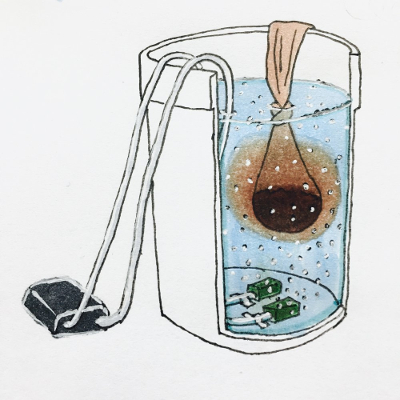
Compost Tea Recipe
By Ben Mardis
In the spirit of permaculture and self reliance, making compost tea is an easy and effective way to generate your own nutrient and biologically rich soil amendments without having to purchase synthetic fertilizers and other off-the-shelf products. Why should growing your own food be expensive?
When searching for a compost tea recipe you will likely come across a multitude of sources; all with their own concoctions and recommended supplemental additives. You can make compost tea recipes as simple or complicated as you like.
Before jumping into making your own brew, let’s get a foundation of knowledge to draw upon so we can make educated decisions. In this article I’ll give you the basic run-down on compost tea and several recipes.
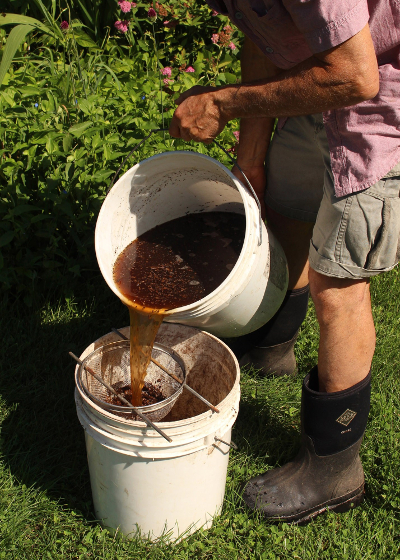 Making compost tea
Making compost teaWhat is compost tea?
First off, let’s make it clear that there are two main types of compost tea, aerobic and anaerobic. Both are used as different strategies to manage soil fertility and plant health.
Aerobic compost tea is an aerated (oxygenated/not stagnant) brew made from compost used to introduce beneficial micro-organisms into your soil. These micro-organisms (fungi, bacteria, nematodes, protozoa, etc.) are crucial to performing the basic processes of building and maintaining healthy soil such as assisting decomposition of plant material, dispersing water and nutrients, and aiding in aeration.
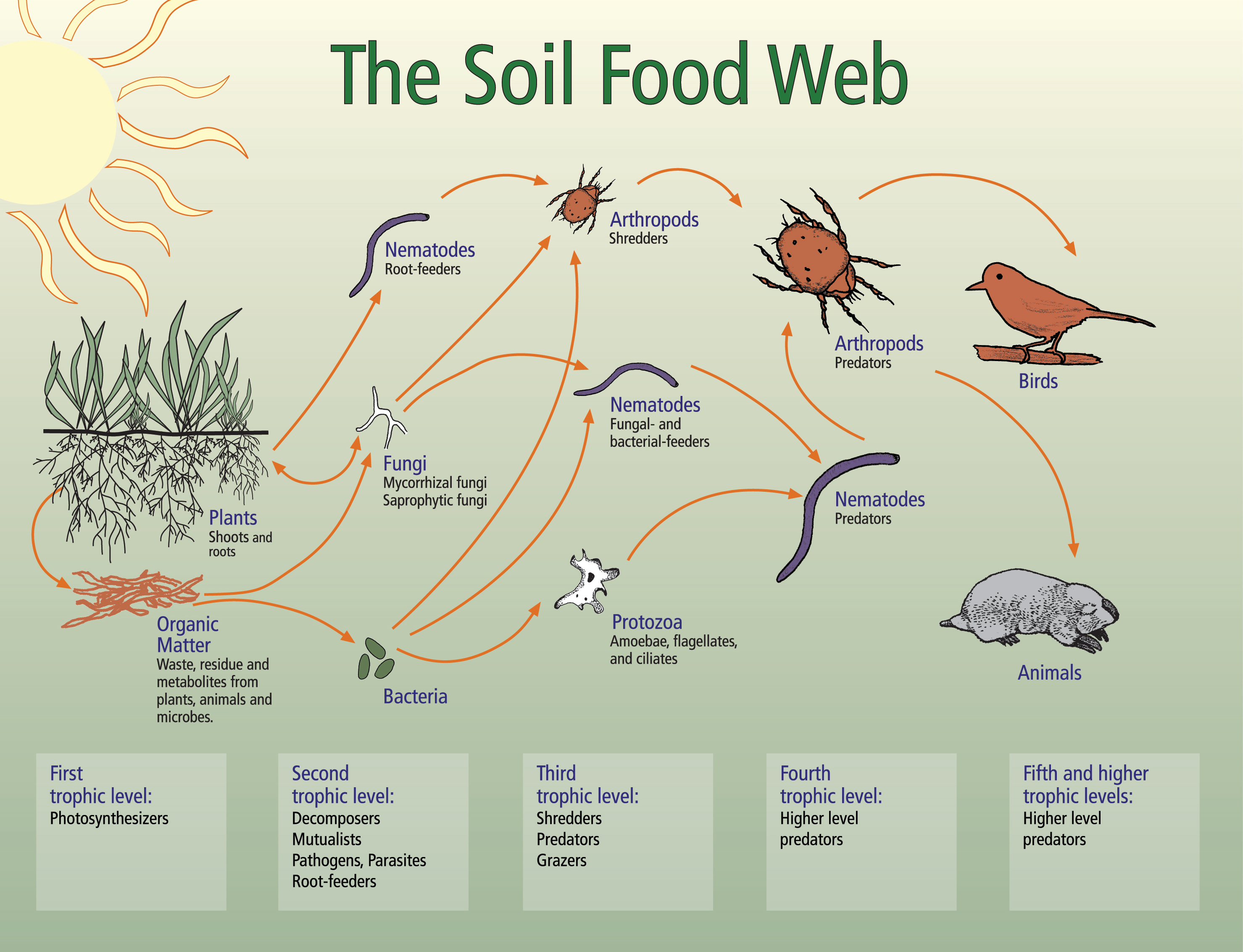
In managing the soil biota we are helping to maintain a healthy soil food web. These micro-organisms will help keep a healthy balance of life in the soil and aid against many plant diseases.
Some applications of a compost tea recipe are more appropriate if the tea you make is bacterially-dominated (more bacteria than fungi) or fungally-dominated (more fungi than bacteria).
For example, a fungally-dominated aerobic compost tea recipe can be used as a foliar spray (spraying onto the leaves) to help combat fungal diseases such as powdery mildew. For more information on this I highly recommend that you read “Teaming with Microbes” by Jeff Lowenfels and Wayne Lewis.
Anaerobic compost tea, also known as compost extract, is a non-aerated (low to no oxygen/stagnant) brew used as liquid fertilizer to be sprayed, splashed, or added to an irrigation system in a method known as fertigation.
Fertigation is the process of using water soluble fertilizers such as fish, seaweed emulsion, and anaerobic teas to add nutrients to the soil in liquid form.
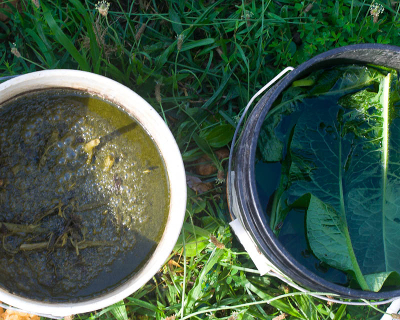
Anaerobic compost tea is used by many cultures for improving soil fertility and is typically made by submerging some form of compost or plant material in water for extended periods of time to ferment.
Some people have concerns using anaerobic teas primarily because of the risk of breeding and spreading harmful pathogens when using compost with animal manures, especially when used on vegetable crops that are eaten raw. This is because many pathogens thrive in an anaerobic environment.
One example would be harmful strains of E. coli that could propagate in a compost tea, although this can largely be mitigated by using well-aged manures and good compost in your tea. Keep in mind that although pathogens can grow in anaerobic conditions, many beneficial bacteria can thrive as well. Kombucha, sauerkraut, kimchi, miso, and many cheeses are all products of fermentation, an anaerobic process.
If you want to use anaerobic teas, do more specific research on the materials that you have to work with or try one of the simple recipes provided in this article to get started.
Compost Leachate:
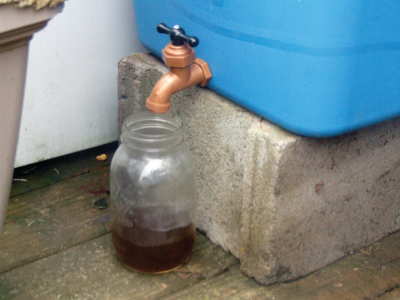
You know that dark liquid you might collect from excess moisture draining out of your compost or worm bin? That’s known as compost leachate and is different than compost tea. Although compost leachate will have some microorganisms and nutrients present, it will not be as effective as making a compost tea to add to your soil.
Be More Prepared For Your Next Outdoor Adventure!

Don't leave without knowing these six essential survival skills. Our free survival mini guide reveals the strategies of:
- Shelter & fire to prevent the number one cause of death
- Obtaining clean water to avoid life-threatening dehydration
- Common wild survival foods and other critical skills!

Why Compost Tea?
Using a compost tea recipe allows us to spread out the benefits of compost to an area larger than could be covered if the compost pile itself was applied.
For example, you may have just enough compost to put a nice thick layer onto a single garden bed but you have three beds. Using a compost tea recipe, you could spread out the benefits of your compost among all your beds.
Alright, now that we have a solid knowledge-base, let’s get into how to make compost tea, specifically aerobic compost tea.
There are many different setups available from prefabricated brewers to simple, do-it-yourself style rigs. Some of them might seem a bit complicated but their main components all perform the same basic functions. Let’s take a look at one of the simplest setups for aerobic compost tea, the "Bucket Brewer".
 Bucket brewer
Bucket brewerBucket Brewer Components:
Bucket: This can be any size but a 3 or 5 gallon bucket will make more than enough tea to thoroughly cover a large garden area.
Aquarium air pump and plenty of plastic tubing: You should try to get a pump with two outlets or two, single outlet pumps. Keeping your brew well aerated is essential to making compost tea.
Air stones or soaker hose: Air stones are meant to stay on the bottom of an aquarium floor to properly aerate the water so your fish don’t suffocate. They perform the same function for the micro-organisms in your compost tea, remember, we’re going for aerobic tea. You can also secure and coil soaker hose along the bottom of the bucket to emit bubbles.
Permeable bag: This is particularly useful when you’re going to be using a sprayer and don’t want compost particulates clogging up your equipment. A pair of pantyhose works great for this. *Whatever bag or sprayer you use, make sure it has a mesh/nozzle size of at least 400 micrometers. This size is large enough to let micro-organisms pass through but not the larger particulates you are trying to contain.
Compost: Whether you are using compost from your backyard or from the worm bin, make sure it is well aged compost, otherwise known as “good compost”. If you’re finding food scraps and other unprocessed material in your compost then it has not been given enough time to break down fully. Let your compost sit until everything has broken down.
Nutrient additives: These are used to feed the micro-organisms during the brewing processes. There are many nutrient additives that you can use; nonsulfured molasses, fruit juices, and other sugary syrups are some of the cheapest available.
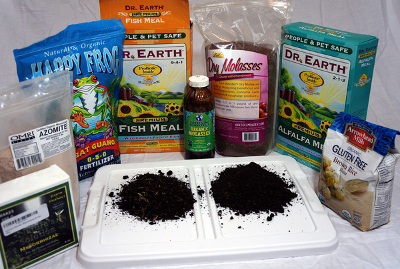 Possible nutrient additives
Possible nutrient additivesAerobic Compost Tea Recipe (5-gallon batch):
A 5-gallon batch of compost tea will be enough to cover about an acre
Instructions:
- Ensure air stones or soaker hose bubbler is in place and functioning correctly.
- Fill bucket with unchlorinated water. Chlorine is very effective at killing micro-organisms. An easy way to dechlorinate your water is to run the air pump through the water for a few hours to let the chlorine evaporate. An alternative would be to let the bucket of water sit out overnight to evaporate the chlorine.
- Add about 4 cups of compost to a permeable bag (at least 400 micrometers) and suspend in the 5 gallon bucket.
- Add two tablespoons of pineapple juice or any other nutrient additive.
- Turn on air pump and allow the tea to brew for about 24-36 hours. During this time-frame the micro-organisms will have consumed the nutrient additives and reproduced many times reaching a peak of population.
- For best results, use within four hours of brewing. After brewing there will be an unsustainable population of micro-organisms in the tea and shortly after the process they will start to die off. Although the efficacy of the tea will diminish, it will remain viable for a day or two after brewing. Eventually the tea will become anaerobic and smelly if not used.
Pour the tea into a size-suitable sprayer or get ready to splash it over your garden.
That’s it!
When and how to use your compost tea:
Congratulations! You’ve made your compost tea. There are some things to consider before throwing on your boots and running to the garden.
- When using aerobic compost teas, don’t worry about over-application, you can’t over-do it.
- UV light kills many micro-organisms so plan on applying your compost tea early in the morning or in the late afternoon.
- Frequency of applications depends on the health of your plants and soil as well as your goals. As routine garden maintenance perhaps you should plan on 2-3 applications a year, once in the fall, spring, and summer. If you are trying to combat plant diseases you should plan on using compost tea on a weekly basis.
Simple Anaerobic Compost Tea Recipes
Where aerobic compost teas are used to propagate and distribute micro-organisms, anaerobic compost teas are used as liquid fertilizers. Anaerobic compost teas are extremely simple to make. Just take the material in question, be it compost, manure, or plant material and put it in a bucket to soak and ferment. Anaerobic teas can be smelly and have the previously mention concerns with harmful pathogens. Remember these concerns are largely related to teas made with animal manures.
Here are a couple of simple anaerobic teas you can make to avoid buying synthetic fertilizers.
Alfalfa Tea:
Alfalfa is a good source of N(nitrogen),P(phosphorus), K(potassium), and some trace minerals. Apply this tea to the root zone of your annuals and perennials every 2-3 weeks to give them a boost.
- 1 cup alfalfa meal or pellets - As alternative to buying meal or pellets, you can purchase a bail of alfalfa hay and put a handful through a food processor.
- 5 gallon bucket
- Add the alfalfa to the bucket and fill with unchlorinated water. Let sit 12-24 hours then apply as a soil drench. Pour any excess into containers and store in the refrigerator. Use stored tea as soon as possible.
Comfrey, Dandelion, or Stinging Nettle Extract:
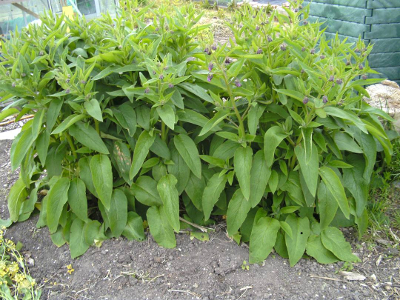 Comfrey
ComfreyExtracts are very concentrated and require dilution before application to avoid damaging plants. Since homemade extracts can be variable in potency, a good rule of thumb is about one tablespoon of extract per gallon of water.
Comfrey, dandelion, and stinging nettle are all great sources of potassium, phosphorus, and many trace minerals.
These are just a few members of a group of plants known as "dynamic accumulators". Dynamic accumulators are plants that are known to take up and store high concentrations of certain vitamins and minerals in their roots and leaves.
Dandelion and stinging nettle can be found growing prolifically in many areas around parks, waterways, and right outside your front door. As a cultivar, comfrey is an extremely hardy and vigorously growing plant that produces a lot of biomass (plant material).
Here’s what you need:
-5 gallon bucket
-Comfrey, dandelion, or stinging nettle leaves (Use young healthy leaves and avoid using mature and ragged or diseased leaves).
Instructions:
- Fill the bucket with plant material. Don’t pack it down.
- Fill bucket with unchlorinated water and cover.
- Let this sit for a couple of weeks if the weather is warm. If the weather is cold, let it sit for about a month.
- During this time the tea will begin to ferment, breaking down the plant material and breeding anaerobic bacteria eventually turning the contents of your bucket into a dark, nutrient-rich smoothie. Where aerobic teas will have a pleasant odor, anaerobic teas will be smelly and have an eau-de-sewer.
- Pour the extract through something to filter out the solids and your extract is ready to use!
Remember to dilute your extract before application. Use as a soil drench around the root zone of your plants.
Store excess extract in the fridge.
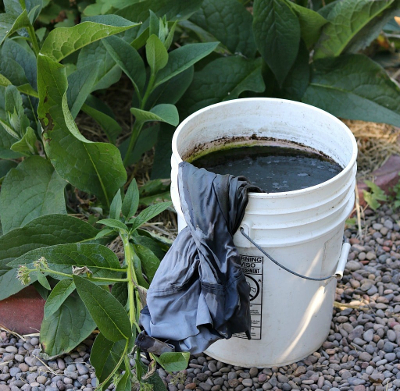 Extract
Extract*Citizen scientist challenge: Did you know that you don’t have to have a degree to be a scientist? With the dizzying amount of information available revolving around soil fertility and the many methods of managing it, there is still a lack of actual scientific data and controlled experiments to back up much of information that is out there. With the extreme variability of one person’s soil to the next, as well as a multitude of other factors (climate, flooding, drought, soil type, current soil fertility, etc.) this isn’t surprising.
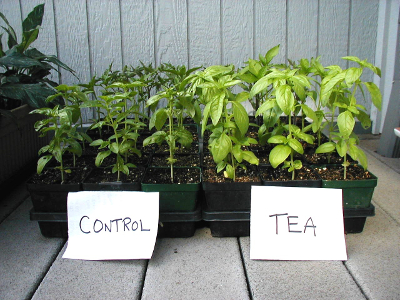 Compost tea experiment
Compost tea experimentThis year, pick a dozen different plants around your garden and do some experimenting of your own with a compost tea recipe. A great experiment could look something like this:
Control plants (water only)
-3 tomato plants
-3 eggplants
Variable plants
-3 tomato plants (alfalfa tea, 1 pint per every 2 weeks)
-3 eggplants (comfrey extract, 1 pint per every 2 weeks)
Keep meticulous records throughout the process.
- What soil amendments were used in the initial garden bed preparation? How much was used and what was it largely comprised of?
- How often did you water the control plants? How often did you apply teas or extracts to the variable plants?
- Were there any pests or weeds inhibiting any of the plants?
- Take measurements of plant growth and note any additional details.
- Take pictures throughout the process!
If you conduct an experiment, please share it with us!
Now go forth and brew up a compost tea recipe!
By the way, a big part of why we love homesteading & permaculture skills so much is because they are a natural extension of learning about wilderness survival (both fields are all about self-sufficiency and working with nature to satisfy needs). An understanding of survival not only helps you become a better permaculturist, it empowers you with life-saving outdoor skills to keep you safe when out in nature. Right now you can get a free copy of our mini survival guide here, where you'll discover six key strategies for outdoor emergencies, plus often-overlooked survival tips.
Compost Tea Recipe References:
Compost Tea Recipe on diynetwork.com
Compost Tea Recipe Guide on kisorganics.com
“Teaming with Microbes” by: Jeff Lowenfels and Wayne Lewis
Related Resources:
Permaculture Courses at Alderleaf

About the Author: Ben Mardis is an experienced educator that is passionate about permaculture and naturalist skills. He is a guest instructor at Alderleaf. Learn more about Ben Mardis.
Return from Compost Tea Recipe back to Permaculture Articles
Is The Essential Wilderness Survival Skills Course Right for You? Take the "Online Survival Training Readiness" Quiz
See for yourself if this eye-opening course is a good fit for you. It takes just a few minutes! Get your Survival Training Readiness Score Now!

Grow Your Outdoor Skills! Get monthly updates on new wilderness skills, upcoming courses, and special opportunities. Join the free Alderleaf eNews and as a welcome gift you'll get a copy of our Mini Survival Guide.

 The Six Keys to Survival: Get a free copy of our survival mini-guide and monthly tips!
The Six Keys to Survival: Get a free copy of our survival mini-guide and monthly tips!
Learn more